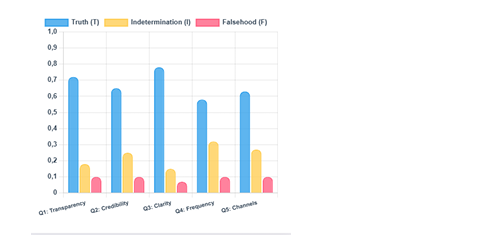Citizen Perception of Institutional Communication: A Study with Plithogenic Hypotheses
Keywords:
Institutional Communication, Citizen Perception, Plithogenic Hypotheses, Neutrosophy, Un certainty, Public Trust, Political Language.Abstract
his study employed a mixed-methodology with a quantitative focus to analyze citizen perception of insti
tutional communication. The approach utilized structured surveys with plithogenic scales and was supple
mented by semi-structured interviews. The core methodology involved modeling a central hypothesis using
neutrosophic logic, which frames citizen perception in triadic terms of acceptance (Truth), rejection (False
hood), and uncertainty (Indeterminacy). To theoretically validate this hypothesis, the study conducted a
stance detection analysis on scientific literature related to key communication variables like transparency and
credibility.The results present two main findings. First, direct surveys with citizens revealed that 42% had
moderate acceptance of institutional messages, 28% showed explicit rejection, and 30% were uncertain. Sec
ond, the theoretical analysis of literature yielded a final Univariate Neutrosophic Probability (UNP) of
(T=0.58, I=0.32, F=0.10). This result validated the research hypothesis with a 58% probability of truth, while
highlighting that 32% of the information in the analyzed framework is indeterminate. The convergence of
these findings confirms that uncertainty is a substantial component of public perception.
Downloads

Downloads
Published
Issue
Section
License
Copyright (c) 2025 Neutrosophic Sets and Systems

This work is licensed under a Creative Commons Attribution 4.0 International License.






